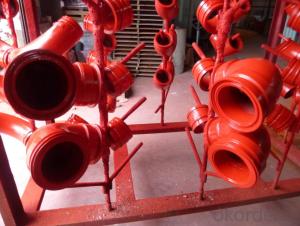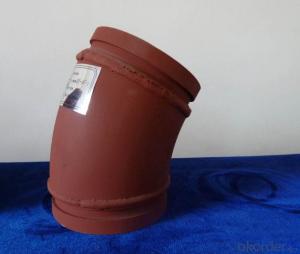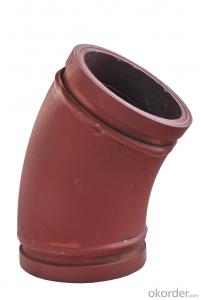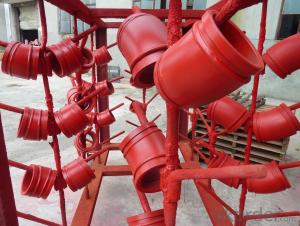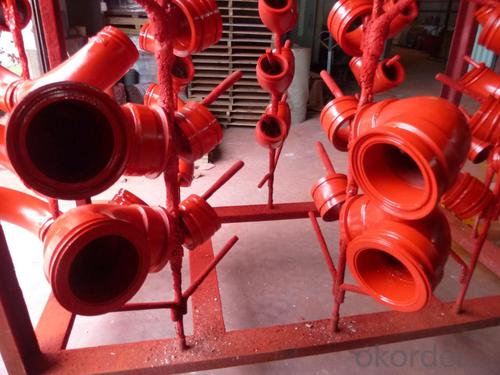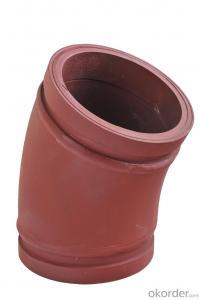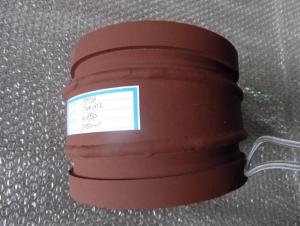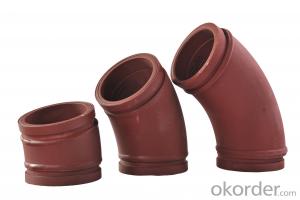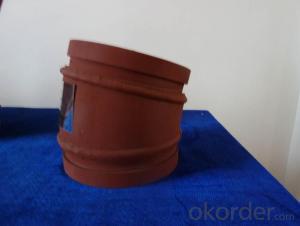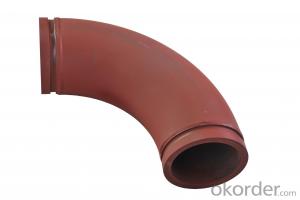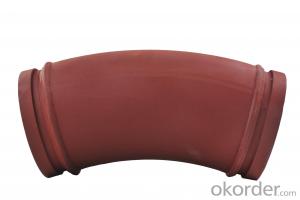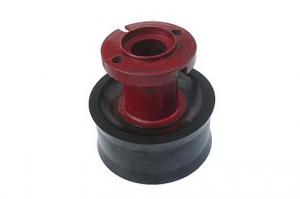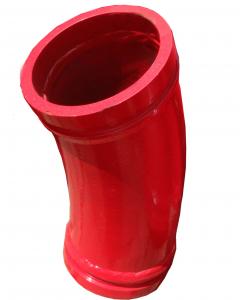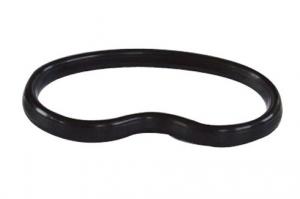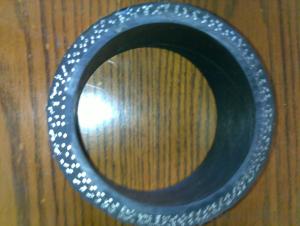Twin Wall Elbow for Concrete Pump R275 30DGR
- Loading Port:
- Tianjin
- Payment Terms:
- TT or LC
- Min Order Qty:
- 50 pc
- Supply Capability:
- 5000 pc/month
OKorder Service Pledge
OKorder Financial Service
You Might Also Like
Product Description:
Product Name: Twin Wall Pipe for Concrete Pump Pipe
Specification
(1) Material: Q235 (outside) + GCr15(inside)
(2) Thickness: 3mm (outside) + 9mm (inside)
(3) Technology: Quenching under high temperature
(4) Characteristics: the inner rigidity to 63 HRC; the outside has so high toughness to keep the inner.
(5) Matched with: Twin wall flange, Alloy (GCr15) + 20#
(6) Working Pressure:170bar
(7) Service life: above 60,000 cubic meters.
(8) Package: PP woven bag and plastic cap
Twin wall elbow is created with research of us and need of the market. Its service life and working pressure are better than the casting. Besides, We can supply 90D, 45D, 30D, 25D, 20D, 15D, 10D. And it can be used for PM, JUNJIN, Schwing, Cifa, Sany, ect.
3. Application
Concrete delivery.
4. Package
Put into containers.
FAQ:
Q1: Why buy Materials & Equipment from OKorder.com?
A1: All products have its ISO certifications, adheres to the highest standards and a commitment to supply chain safety and customer satisfaction.
Q2: How do we guarantee the quality of our products?
A2: We have established an advanced quality management system which conducts strict quality tests at every step, from raw materials to the final product. At the same time, we provide extensive follow-up service assurances as required.
Q3: How soon can we receive the product after purchase?
A3: Within three days of placing an order, we will begin production. The specific shipping date is dependent upon international and government factors, but is typically 10 to 30 workdays.
Q4: If we can produce Twin Wall Pipe for Concrete Pump Pipe according to customers request?
A4: Yes, we can produce Twin Wall Pipe for Concrete Pump Pipe according to the difference country situations to make it suitable to the market and customers. We have very professional technical team to make the design.
Q5: How to make a quick resolution for after service?
A5: We have overseas branches all-around of world, If needed, the seller shall dispatch 2 engineers to the buyer's site for supervision of training. The buyer shall make available of necessary facilities &skilled personnel at site for training.
Images:
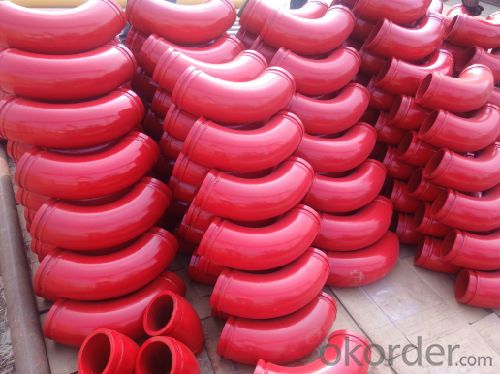


- Q: What are the skills of concrete pump?
- The operator and equipment management personnel should carefully read the instructions, grasp the relevant knowledge of the structural principle, use and maintenance as well as pumping concrete; use and operation of the concrete pump, should be strictly in accordance with the execution of instructions
- Q: What are the different sizes of concrete pump pipes available?
- The sizes of concrete pump pipes available vary depending on the specific needs and requirements of the construction project. Typically, concrete pump pipes come in sizes ranging from 2 inches to 6 inches in diameter. The most commonly used sizes are 2 inches, 3 inches, 4 inches, and 5 inches. The choice of pipe size depends on factors such as the volume and pressure of the concrete being pumped, the distance the concrete needs to travel, and the type of equipment being used. Smaller diameter pipes are suitable for shorter distances and lower volumes of concrete, while larger diameter pipes are used for longer distances and higher volumes. It is important to select the appropriate pipe size to ensure efficient and safe concrete pumping. Using the correct size of pipe helps to minimize pressure loss, maintain a consistent flow rate, and prevent blockages or clogs in the system. Consulting with a concrete pumping professional or engineer is recommended to determine the most suitable pipe size for a specific construction project.
- Q: What is the function of a concrete pump control lever?
- The function of a concrete pump control lever is to control the flow and direction of the concrete being pumped. It allows the operator to start and stop the pump, adjust the speed of the pump, and control the placement and placement speed of the concrete. The control lever also enables the operator to switch between different pumping modes, such as pumping vertically or horizontally, and adjust the pressure of the concrete being pumped. Overall, the control lever is essential in ensuring accurate and efficient concrete pumping operations.
- Q: How often should concrete pump remote controls be inspected and maintained?
- To ensure proper functioning and prevent any potential issues, it is important to regularly inspect and maintain concrete pump remote controls. The frequency of inspections and maintenance depends on factors such as usage intensity, environmental conditions, and manufacturer recommendations. As a general rule, it is recommended to inspect and maintain concrete pump remote controls once every three months. During these inspections, check for visible damage, loose or worn-out parts, and ensure that all buttons and switches are working correctly. Additionally, inspect and clean the battery compartment, and replace batteries if needed. However, in situations where there is high demand or extreme environmental conditions, more frequent inspections and maintenance may be necessary. For example, if the concrete pump is used in a harsh environment with excessive dust or moisture, it is advisable to increase the frequency of inspections and cleanings to prevent damage or malfunction. Following the manufacturer's guidelines and recommendations for maintenance is crucial. They may provide specific instructions on lubrication, calibration, or other maintenance procedures that should be carried out regularly. By adhering to these guidelines, concrete pump remote controls can be kept in optimal condition, ensuring safe and efficient operation.
- Q: What are the indications of a worn-out concrete pump clamp?
- There are several indications that a concrete pump clamp may be worn out and in need of replacement. Some common indications include: 1. Leaking: If you notice any leaking around the clamp area while the concrete pump is in operation, it could be a sign of a worn-out clamp. This leaking could be due to a faulty seal or gasket, which may no longer be able to create a tight and secure connection between the pump and the hose. 2. Vibrations and rattling: A worn-out clamp can cause excessive vibrations and rattling during the pumping process. This could be due to the clamp no longer being able to hold the hose firmly in place, leading to movement and instability. 3. Difficulty in tightening: If you find that it is increasingly difficult to tighten the clamp properly, it may indicate that the clamp is worn-out. Over time, the clamp's components can become worn, making it harder to achieve a secure and tight connection. 4. Visual signs of damage: Inspect the clamp for any visual signs of damage, such as cracks, dents, or corrosion. These physical damages can compromise the clamp's ability to function effectively, leading to potential leaks or instability. 5. Excessive wear and tear: If you have been using the same concrete pump clamp for an extended period without replacement, it is advisable to inspect it regularly for signs of excessive wear and tear. This could include worn-out or missing bolts, a deformed clamp body, or any other visible signs of deterioration. It is essential to address any indications of a worn-out concrete pump clamp promptly to ensure the safety and efficiency of the pumping operations. If you observe any of these signs, it is recommended to consult a professional or replace the clamp to avoid potential accidents or disruptions in the concrete pumping process.
- Q: What are the different types of concrete pump hydraulic filters?
- There are several different types of concrete pump hydraulic filters that are commonly used in construction projects. These filters play a crucial role in ensuring the smooth operation and longevity of the hydraulic system in concrete pumps. 1. Suction filters: These filters are located at the intake side of the hydraulic pump and are responsible for removing larger particles and debris from the hydraulic oil. They prevent the pump from drawing in contaminants that can cause damage to the pump and other components. 2. Return line filters: Positioned on the return line of the hydraulic system, these filters are designed to remove smaller particles and contaminants from the hydraulic oil before it is returned to the reservoir. They help maintain the cleanliness of the hydraulic oil, preventing wear and tear on the system. 3. Pressure line filters: These filters are installed on the high-pressure side of the hydraulic system, typically after the hydraulic pump. They are responsible for removing fine particles and contaminants from the oil, ensuring the smooth operation of valves, cylinders, and other hydraulic components. 4. In-tank filters: These filters are submerged in the hydraulic oil reservoir and are used to filter the oil as it circulates through the tank. They are effective in removing larger particles and contaminants that may have settled at the bottom of the reservoir. 5. Magnetic filters: These filters utilize magnets to attract and remove metallic particles from the hydraulic oil. They are particularly effective in capturing ferrous contaminants, such as iron filings and metal shavings. 6. Breather filters: These filters are installed on the breather vent of the hydraulic oil reservoir. They prevent dust, dirt, and moisture from entering the system, maintaining the cleanliness and integrity of the hydraulic oil. It is important to regularly inspect and replace these hydraulic filters to ensure optimal performance and longevity of the concrete pump's hydraulic system. Failure to do so can result in increased wear and tear, decreased efficiency, and potential damage to the pump and other components.
- Q: What is the function of a concrete pump control box?
- The function of a concrete pump control box is to control and regulate the operation of a concrete pump, including starting and stopping the pump, adjusting the flow rate and pressure of the concrete, and monitoring various parameters such as engine speed and hydraulic pressure. It provides a centralized control system for efficient and safe operation of the concrete pump.
- Q: How often should concrete pump filters be inspected and replaced?
- Regular inspections of concrete pump filters are recommended, ideally once a week. The replacement frequency will vary based on factors such as pump type, concrete quality, and working conditions. Typically, clogged or inefficient filters should be replaced. This can happen every few weeks to a few months. It is essential to keep filters clean and functional to avoid blockages, improve pump performance, and prolong equipment lifespan.
- Q: What are the advantages of using genuine spare parts for my concrete pump?
- There are numerous benefits to utilizing authentic spare parts for your concrete pump. Firstly, these genuine components are specifically designed and produced by the original equipment manufacturer (OEM) for your concrete pump. This guarantees a perfect fit and optimal functioning with your particular model. By using genuine parts, you can avoid compatibility issues or malfunctions that may arise from using aftermarket or counterfeit parts. Furthermore, authentic spare parts are crafted from high-quality materials and undergo rigorous testing to meet stringent quality standards. This ensures their durability, reliability, and performance, resulting in a longer service life and reduced downtime for your concrete pump. Genuine parts are engineered to withstand the demanding conditions and heavy loads commonly encountered by concrete pumps. Moreover, the use of authentic spare parts helps preserve the warranty and integrity of your concrete pump. Many manufacturers offer warranties that cover the utilization of genuine parts. By utilizing genuine parts, you can take advantage of the warranty benefits and avoid any potential problems that may arise from using non-genuine parts, which could invalidate the warranty. In addition, authentic spare parts often come with technical support and expertise from the manufacturer. OEMs possess extensive knowledge and experience with their equipment, and their technical support team can provide guidance, advice, and troubleshooting assistance in the event of any issues. This can be highly advantageous in minimizing downtime and maximizing the efficiency of your concrete pump. Lastly, the use of authentic spare parts ensures the safety of your equipment and operators. Genuine parts are manufactured to meet strict safety regulations and standards, reducing the risk of accidents or failures that can result from using substandard or counterfeit parts. The safety and well-being of your team should always be a top priority, and the use of genuine parts helps guarantee their protection. In conclusion, the utilization of authentic spare parts for your concrete pump offers a range of advantages, including compatibility, quality, durability, warranty coverage, technical support, and safety. Investing in genuine parts not only enhances the performance and longevity of your equipment but also provides peace of mind for both you and your team.
- Q: What are the advantages of using OEM (Original Equipment Manufacturer) concrete pump spare parts?
- There are several advantages of using OEM concrete pump spare parts. Firstly, OEM parts are specifically designed and manufactured by the original equipment manufacturer, ensuring a perfect fit and compatibility with your concrete pump. This results in optimal performance and efficiency, minimizing downtime and costly repairs. Secondly, OEM parts are made from high-quality materials, meeting strict industry standards and specifications. This guarantees durability and longevity, reducing the need for frequent replacements. Additionally, OEM parts often come with warranties, providing peace of mind and protection against any manufacturing defects. Lastly, using OEM parts ensures the preservation of your concrete pump's warranty and resale value. Overall, opting for OEM concrete pump spare parts ensures reliability, performance, and cost-effectiveness in the long run.
Send your message to us
Twin Wall Elbow for Concrete Pump R275 30DGR
- Loading Port:
- Tianjin
- Payment Terms:
- TT or LC
- Min Order Qty:
- 50 pc
- Supply Capability:
- 5000 pc/month
OKorder Service Pledge
OKorder Financial Service
Similar products
Hot products
Hot Searches
Related keywords
